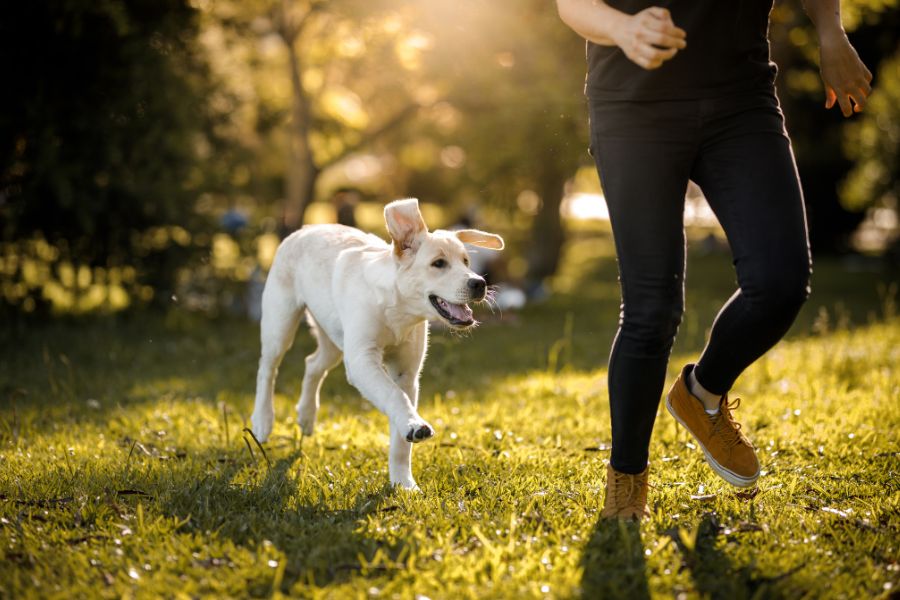E-collars are often seen as a controversial dog training tool, and I’ve realized that it’s largely because people don’t understand them. There are a lot of misconceptions about dog training methods, and this blog post aims to clear up the distinct difference between shock collars and e-collars! Today I’m writing about 5 dog E-Collar training benefits that all dog owners should know about.
So grab your favorite treat pouch, a long leash, and you’re happy dog to embark on this journey with us!

My Journey to Dog E-Collar Training
Once upon a time, I staunchly adhered to the “Force Free” approach to dog training, advocating solely for positive reinforcement methods. The mere thought of employing an electric collar on my beloved canines was unthinkable, and I admittedly cast judgment on those who did.
My perception of E-Collars was clouded by the misconception that they were instruments of punishment, inflicting shocks and discomfort on dogs simply for behaving naturally.
However, I gradually realized this was a narrow view influenced by common misconceptions. While it’s true that some individuals misuse cheap shock collars, subjecting dogs to unnecessary punishment, an entirely different realm of modern E-Collar training methods prioritizes freedom, enjoyment, and effective communication for dogs.
My perspective shifted dramatically when confronted with owning a fence-jumping Great Dane.
While my Dane’s sibling, who underwent e-collar training, reveled in off-leash freedom, displaying happiness, confidence, and responsiveness, my dog was frustrated being stuck on a long leash in his yard.
Witnessing this stark contrast between the two siblings compelled me to reconsider my stance and explore the potential benefits of modern E-Collar training methods.
When I opened my perspective to it, our whole world changed!

#1 – Ditch the Long Leash
The most powerful benefit of E-Collar training is that you and your pet can eliminate the obstructive, annoying, and potentially dangerous long leash.
Of course, using a leash in areas where being off-leash violates your local ordinances and laws is important.
The E-Collar should be the tool of choice for places where being off-leash could be done legally and safely. Because a physical leash does not restrain them, nothing obstructs their movement.
Long leashes, while seemingly providing freedom for dogs, can pose various risks and dangers if not used cautiously.
Firstly, long leashes increase the risk of entanglement, where the dog may become tangled around objects or even people, leading to potential injury or accidents.
The extended length of the leash can diminish the owner’s control over the dog, especially in situations requiring quick intervention or recall, potentially leading to dangerous situations or the inability to prevent conflicts with other dogs or people.
While long leashes have their place, they are NOT a replacement for training a solid recall.
Furthermore, long leashes can inadvertently encourage undesirable behaviors, such as pulling or bolting, as the dog may perceive the extended length as a license for unrestrained behavior.
Advocates for the “force-free” dog training method will rely heavily on long leashes as a solution for dogs that will run away, even after years of positive-only training. This is where E-Collars should enter the conversation.

#2 – Freedom to Explore
There are many places to explore where your pet could be safely off-leash if they are E-Collar trained! Imagine trekking through a field, down a hiking path, or camping with your dog safely nearby, responsive to you, and free to explore without physical restraint.
With modern E-Collar training, dogs can learn to ignore and avoid distractions, including other dogs, wildlife, bikes, and people. They come when called 100% of the time.
Even your front yard could be an incredible place for your pet to be off-leash if only you had a gentle, effective, and positive communication method.
Off-leash time fosters natural behaviors, such as running, sniffing, and exploring, which are vital for a dog’s physical and mental well-being. It strengthens the bond between owner and dog as they navigate their surroundings, fostering trust and communication.
Enter the modern E-Collar!

#3 – Precise Communication
An e-collar facilitates precise communication between the owner and the dog through its ability to deliver immediate and specific feedback, even from a distance.
It’s important to understand that this feedback doesn’t have to be harsh or unfair! Modern E-Collars use stimulation, not shock, to create a tactile sensation that can be used positively.
The long leash provides tactile feedback to the dog, too. E-Collars replace that sensation with a different one that doesn’t require physical restraint.
Unlike traditional training methods where timing and distance can be challenging to control, e-collars allow owners to deliver corrections or reinforcements with pinpoint accuracy, ensuring that the dog associates the feedback directly with their behavior.
The remote control feature of e-collars enables owners to adjust the intensity of the stimulation or deliver other forms of feedback at the exact moment when the behavior occurs, eliminating any confusion or delay in communication.
This precision in timing and delivery ensures that the dog receives consistent and clear signals, enhancing their understanding of desired behaviors and expediting the training process.

#4 – More Gentle Than a “Gentle Leader”
Gentle Leader head collars are advertised as a gentle solution for pet owners seeking to curb pulling and other leash-related nuisances. Despite this portrayal, these training tools are anything but gentle.
They exert continuous pressure on the dog’s face and eyes, potentially causing discomfort or distress. Additionally, if the dog lunges or pulls, the design of the Gentle Leader can forcibly redirect its head to the side, potentially causing discomfort or injury.
These inherent issues highlight the significant drawbacks of using Gentle Leader head collars.
Interestingly, advocates for such tools often oppose e-collars due to the misconception that they are solely used to administer shocks and intimidate dogs, further illustrating the complexity of the debate surrounding training methodologies.
When employed appropriately, modern e-collars prove remarkably gentle in their approach.
The tactile sensation they deliver is often imperceptible to most humans until it reaches levels far beyond what the average dog requires to respond positively.
It’s crucial to distinguish between shock collar and e-collar training—they are not synonymous methodologies.

#5 – The Dog Makes Their Own Choices
E-collar training empowers dogs to make their own choices by providing them with clear boundaries and consequences for their actions. Through consistent and well-timed feedback delivered via the e-collar, dogs learn to associate their behaviors with specific outcomes.
This allows them to understand the consequences of their actions and make informed decisions accordingly. It gives them control of their situation, which long leashes cannot do.
For example, if a dog learns that ignoring a recall command results in pressure from the e-collar, they may respond because they know that doing so makes the pressure go away.
The sensation generated by the e-collar is not painful or shocking to dogs; rather, it can be likened to the annoyance of the reminder sound your car emits when the seatbelt remains unbuckled. Just as that gentle pressure prompts you to buckle up, the collar’s sensation serves as a gentle reminder or prompt for the dog to heed a command or adjust their behavior.
Much like the car reminder, it doesn’t startle, harm, or hurt the dog; rather, it encourages them to respond appropriately without causing distress.
By allowing dogs to experience the direct consequences of their choices, e-collar training encourages them to make choices that lead to positive outcomes and reinforce desired behaviors.
When implemented correctly, modern E-Collar training is empowering and freeing for dogs. It’s that simple.

What Are the Best E-Collars for Dogs?
I recommend only two brands.
Do not buy a cheap e-collar from Amazon! Stick to name brands and work with a trainer to learn how to use them. Larry Krohn on YouTube is a phenomenal resource for training tricks!
Mini-Educator
This basic system is perfect for most pet owners, especially those new to E-Collar off-leash training!
EZ Educator Collar
The EZ has slightly more features and is made by the same company as the Mini-Educator.
Dogtra E-Collar – Tom Davis Edition
Tom Davis is another phenomenal E-Collar trainer who partnered with Dogtra to make a custom collar.
(The Chewy Link is for the black version)






